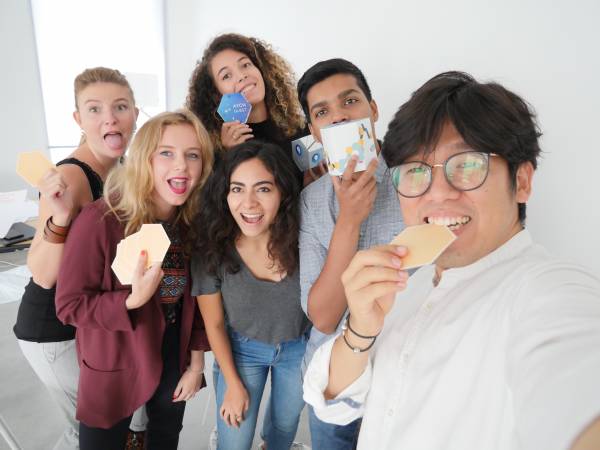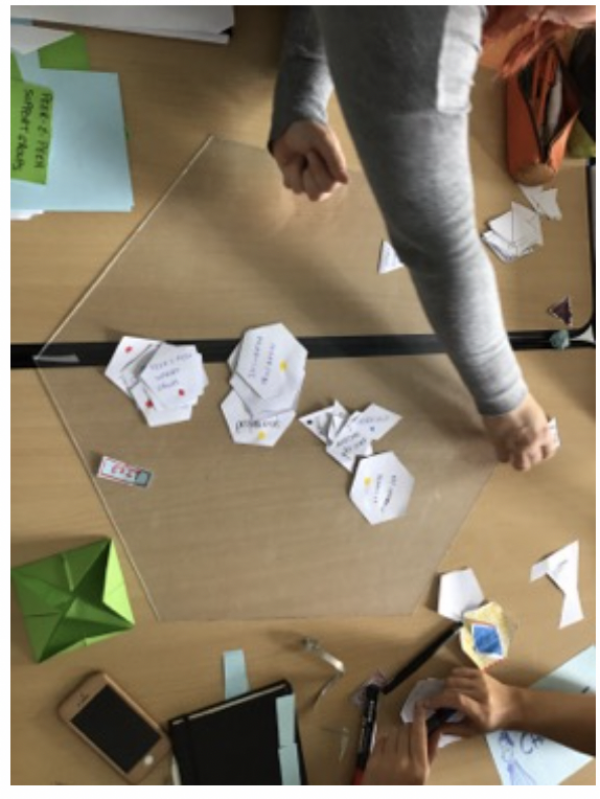AYCH QUEST
Genesis of the project: diversity of approaches and partners: engaging young people & education
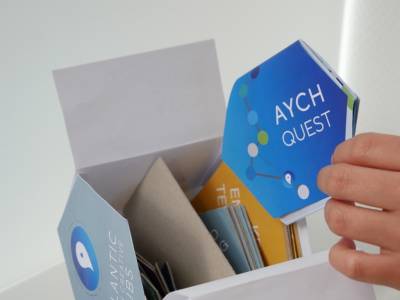
The diversity of partners and approaches has led us to refine our first very classic approach to the AYCH process. With our exchanges with the partners of the youth services, the classical linear and processual journey from the idea to the incubation has gradually been enriched around an educational experience and a path, more adapted to the needs expressed by the participants in the AYCH project.
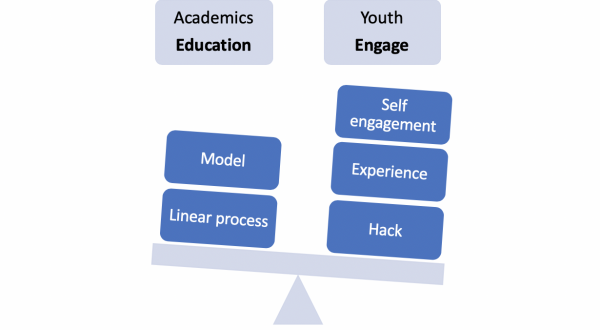
First exchanges between academic partners and youth services
These first exchanges resulted in: * The enrichment of the definitions of stages such as internship, residencies, the incubation (incubation) or key technologies (Key Technologies) which have been expanded to “stick” to diversity profiles, * The need to capitalize and have tools easily appropriated and online, * The possibility of defining stages and its course rather than entering a fixed process.
One of the major difficulties of the project is to acculturate the young people at these stages, but also the partners of the youth services who do not have the same level of maturity on these approaches of entrepreneurship. How to translate this very technocratic process (incubation, key technologies, workshops) and finally very dedicated to students of higher education in a vocabulary adapted for all (youth and youth services)?
A consensus has been established for more flexible and easily accessible processes for all. It remained to implement this approach in practice: a design thinking workshop was proposed by the Nantes Atlantique design school to bring together the various stakeholders and make them work around this common goal.
Workshop and creative process (September 2018): how to make this approach more tangible for partners and young people?
On the occasion of the steering committee in Nantes, a first design thinking workshop brought together education professionals and experts (Clément Gault, Anaïs Jacquard, Oli Raud, Elizabeth Zahoui, youth professionals (Ashton Community Center , Plymouth Youth service …), and finally young people from the L'Ecole de design Nantes Atlantique to rethink AYCH “users” journey, the stages and the vocabulary It should be noted that the tool was then developed within the sustainable city design lab by students potentially eligible for the project The student team was multidisciplinary (product design, space), mixed and international (France, Mexico, South Korea, India), supervised by an interactivity designer.
The joint approach helped to define a first tool, AYCH quest or journey maker that made it possible to materialize the stages of the journey into a game, but also to broaden the definitions of the various stages.
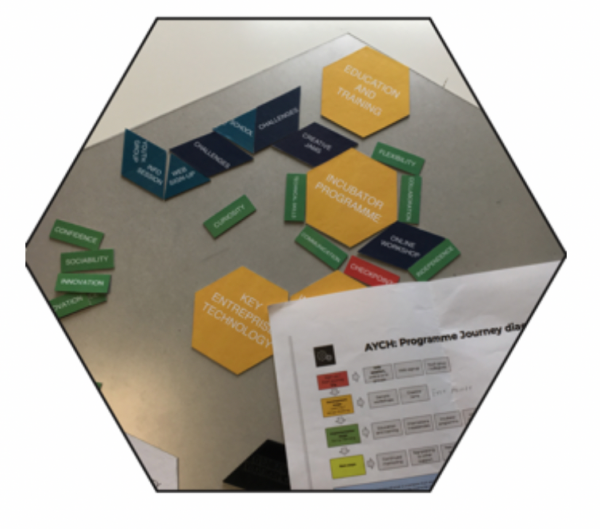 The shift of the journey maker: move from a linear approach in diagram to a personalized approach according to the course of the young person.
The shift of the journey maker: move from a linear approach in diagram to a personalized approach according to the course of the young person.
The steps (and English) were then reworked together with a working group dedicated to this approach (Dan Barton, Oenone Thomas, Eli Zahoui) in a more didactic approach: (starting the journey instead of creative jam, make it happen for residences, etc.)
Elements of design
- The tool is easily transportable or printable at the scale of each hub.
- The formal vocabulary is simple
- The honeycomb shape of the main stages of the course is designed to maximize the interactions between the stages.
- An application was thought out, but the animation is a game to maximize interactions.
- To guarantee anonymity, a photograph of the course and elements is made by the user at each stage of the course, with an avatar.
Numerous digital tools to describe and manage a project or a course already exist. Like Slack, they are most often dedicated to the professional world and have a degree of sophistication that can put off. In addition, they are essentially digital which serves the commitment. Conversely, we find physical tools and manipulables but rather to organize daily. These are more or less open: an agenda for example is too linear for the diversity of the public touched by AYCH; a whiteboard and / or a series of post-it are on the contrary too open and lack of frame.
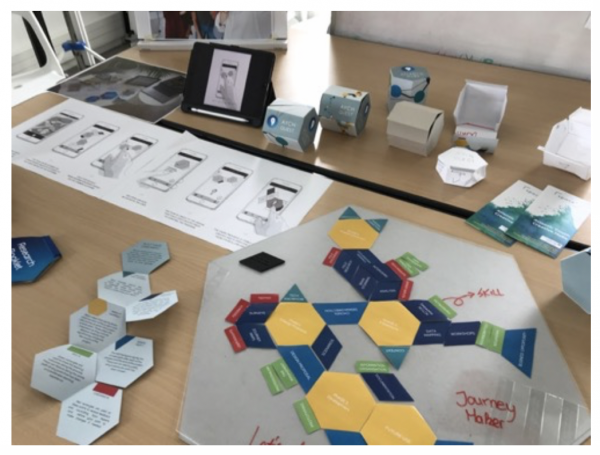 Presentation of the journey maker: an app. is considered but ultimately abandoned to maximize interactions.
Presentation of the journey maker: an app. is considered but ultimately abandoned to maximize interactions.
How to play?
AYCH quest: a journey map is a tool for the visualization of routes (“ journey ” in English) for young people wishing to invest in the AYCH project. The idea behind the participant is more to tell his story. AYCH quest is made up of tiles that represent stages or events to be placed in relation to each other: it has been conceived as a modular tool to best match everyone's experience.
For whom and when?
The use of AYCH quest is variable in size, mainly two moments can be noted: * At the beginning of the course AYCH, it allows the young person to introduce himself and to make a point on his skills and his history. He also has an interest for the supervisor: he can situate the newcomer and guide him as best as possible following his integration with AYCH. * On the way , AYCH quest is used to take stock of what has been accomplished: it offers a time for reflection to initiate and nurture exchanges with a supervisor.
The principle
AYCH quest brings together a series of tiles of different shapes and colors. By placing them relative to each other, the user develops his career. As explained above, the tile game can be used to expose one's post-AYCH experience or advancement within the program.
In all, AYCH quest is composed of six different types of tiles:
Starting the journey , blue triangles, correspond to the starting point. This departure can be when entering the AYCH program, or at the arrival of a course that leads to AYCH. To illustrate :
- Observation
- Background
- Tech knowhow
- etc.
Developping the idea , small blue diamonds, bring together different tools used during the course:
- Interviews
- Field research
- Brainstorming
- etc.
Make it happen! , large yellow hexes, present the key steps of an AYCH journey, include:
- Problem Statement
- Directions
- Design Proposals
- etc.
Where next? , half mauve hexes, are to be understood as intermediate steps resulting from the AYCH course, we find:
- Patent
- Internships
- Collaborations
- etc.
Skills , green rectangles, indicate the different skills acquired during the process:
- Prototyping
- Oral expression
- Time management
- etc.
Checking in , red rectangles, correspond to the returns and notices about a project within AYCH:
- Testing
- Expert inputs
- Field discoveries
- etc.
Finally, to fit all, blank versions for each type of tile also provided.
Downloading the tool
Version 2 :
Laster cuting instructions {{ :en:box.pdf |Box}} Tiles booklet non printable Plexi laser cuting
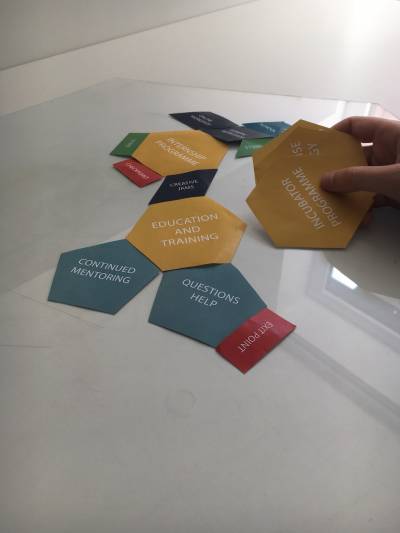
The next steps
The next steps in the development of the tool, whose principle is now tested and validated, will be:
- A deployment in each hub provided by a video tutorial or online, as well as OPEN SOURCE files to print in each hub.
- tests.
- a version 2 to be developed in September 2019.
The success of this tool will be measured in the ability of young people to own it throughout the course.
About
AYCH quest was conceived and realized in september 2018 by students of Design Lab Sustainable City , design research laboratory within L'Ecole de design Nantes Atlantique : Aditya Joshi , Charline Havart , Danae Velez , Hans Seunghoon , Lucie Sénéchal , Suzie Razafimihery .
